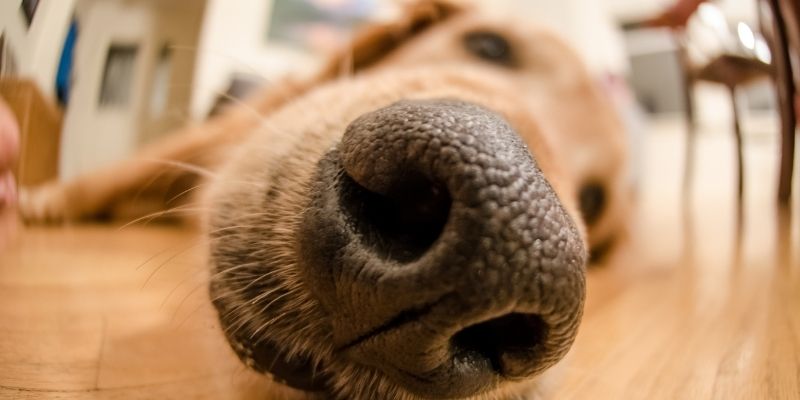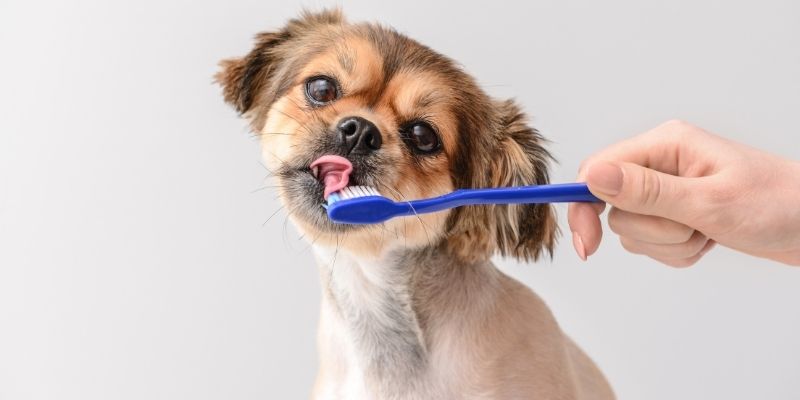If you’re a pet owner, you have undoubtedly heard several myths about pet health. You might even believe some of them unknowingly. While some pet myths are pretty harmless, some may cause harm. Some may even delay the pets from getting the treatment they need.
Below are some of the most common myths about pet health.
Do you have a specific question about the common pet-health misconceptions? Then use the table of contents below to jump to the most relevant section. And you can always go back by clicking on the black arrow in the right bottom corner of the page. Also, please note that some of the links in this article may be affiliate links. For more details, check the Disclosure section at the bottom of the page.
Here's what we'll cover:
- A warm nose means your dog is sick
- Kidney disease affects only old dogs
- Pet insurance is only for senior dogs
- One dog year equals seven human years
- Dogs eat grass because they are sick
- Dog fur is responsible for allergies
- Scraps from the table will not harm your dog’s health
- Year-round parasite prevention isn’t necessary
- My pet is “naturally chubby”
- People and pets can’t share diseases
- It is acceptable for dogs to lick their wounds
- It’s ok to skip brushing pets’ teeth
- Low-carbohydrate diets are better for my pet
- A dog’s mouth is cleaner than a human’s mouth
A warm nose means your dog is sick
It is difficult to understand when this myth came about. Experts said it might be because of distemper—a contagious viral infection that caused a dog’s nose to thicken. That changes the temperature of their noses. However, a warm nose is not a symptom that your dog is sick. There are many reasons why they have warm noses. It could be from the weather, genetics, or normal temperature fluctuations.

Kidney disease affects only old dogs
Although the renal illness is more common in older pets, it can strike at any age. Some breeds, such as Golden Retrievers, Bull Terriers, and Doberman Pinschers, are more likely to develop renal disease than others, but all dogs are at risk.
If you suspect that your dog has a renal illness (excessive drinking and urine are early indicators), take him to the vet right away.
A urinalysis should be conducted to examine the kidney’s ability to concentrate urine. This is accomplished by measuring the specific gravity of the urine, which will be lower than normal in pets with kidney illness. In addition, blood tests to examine kidney function can be performed. The two most prevalent are creatinine and BUN, or blood urea nitrogen.
Pet insurance is only for senior dogs

This is probably one of the most dangerous misconceptions about the health of your pets—the myth that they do not need pet insurance until their old age. The best time to get pet insurance is when you bring your puppy home. You can start looking at pet insurance options if you are considering getting a pet now. E.g. you might want to check this review of pet insurance company, Spot, (since it’s first-time-pet-parents friendly).
One dog year equals seven human years
One of the oldest myths about dogs is that one human year is equal to seven in dog years. It depends on the breed of the dog. A medium-sized dog will be 15 years old in the first year and nine years old in the second year. After that, you need to add five years for every human year. The calculation largely depends on the size of the dog.
Aside from these myths about pet health, there are also some common misconceptions about dogs, cats, and their behavior. Knowing these misconceptions can help you better understand pet behavior.
Dogs eat grass because they are sick

Although there is some truth to this since dogs eating grass might mean internal parasites and nutritional deficiencies, that is not always the case. For many dogs, especially younger ones, eating grass is a form of entertainment and sign of boredom. In any case, it might mean that your pets are bored. Maybe it is time to bond with them.
Dog fur is responsible for allergies
If you are sneezing and have watery eyes, that’s not because of your pets’ fur. Allergic reactions to the pet are caused by dander (skin), saliva, or urine. So, although the pets may still be to blame, it is not because of their fur.
Don’t let these pet health myths distract you from needing to care for your pets through science-based methods. Read up about the specific breed you have. Make sure that your pets are getting a nutritious diet and enough exercise to keep them happy and ensure they live a long life.
Scraps from the table will not harm your dog’s health

This, too, is a myth. In fact, human food can be extremely hazardous to dogs. Dogs are not humans, and they have particular dietary needs that differ from ours to stay healthy.
Consider garlic, onions, grapes, potato leaves, walnuts, and anything containing the artificial sweetener Xylitol—all seemingly harmless items that can be fatal to your dog.
Cooked bones should also be avoided since they can splinter and penetrate the gut.
Furthermore, many table dishes contain excessive amounts of salt, sugar, preservatives, and carbs. So, if you’d like to share some broccoli, go ahead. However, diets heavy in salt, sugar, and fat can be harmful to our pets.
Why is this the case? Simply put, sugars stimulate the pancreas to produce insulin, subsequently used to turn excess glucose into fat. The end outcome is pet obesity.
High-fat diets and snacks cause the release of pancreatic digesting enzymes, leading to life-threatening pancreatitis.
Year-round parasite prevention isn’t necessary
In reality, many veterinarians prefer that pet owners consider parasite control to be preventive medicine. Because some parasites, such as roundworms, can infect pets at any time of year, only ongoing prevention is effective.
To keep your pet safe from fleas, ticks, heartworms, and intestinal parasites use a broad-spectrum parasite prevention medicine; many of these treatments are given or applied once a month. Your veterinarian will assist you in selecting the products that will be most beneficial to your dogs.
My pet is “naturally chubby”

While a chubby cat or chunky dog may appear cute, the health hazards of keeping an overweight or chubby pet are not. Obesity in pets can be avoided and should be treated carefully. Obesity can put your pet at risk for various illnesses, including heart disease, diabetes, osteoarthritis, bladder stones, some malignancies, and a shorter lifespan.
Here are a few basic tips for determining whether or not your pet is overweight:
From shoulder to tail, run your palm flat along your pet’s body. If your pet is a healthy weight, you should be able to feel their ribs without a heavy coating of fat or having to push too hard.
When gazing at your pet from above, you should be able to see their “waist.” A decent rule of thumb is that your pet’s shoulders should be broader than its abdomen.
Your pet’s tummy should not sag low to the ground or droop excessively when viewed from the side.
Zoonotic infections are spread between humans and animals. The most well-known zoonotic illness is rabies, but it is not the only one. Scratch illness, salmonellosis, roundworm, hookworm, ringworm, and toxoplasmosis are among the others.
Wash your hands after petting your pet or handling urine or feces to lower your risk of catching a sickness from him or her. Do you give your pet a kiss? Although the habit may bring you closer to your pet, it may also make you sick. Bacteria in your dog’s or cat’s mouth can get you sick. Although having a poor immune system increases your chances of becoming ill, saving your kisses for your human family members is a good idea.
It is acceptable for dogs to lick their wounds

Many pet owners believe that allowing their pets to lick their wounds may hasten to heal. However, while there is evidence that some of the enzymes in saliva can help with healing, other things in the mouth can have the opposite effect.
While licking the wound might help eliminate dirt, letting your dog lick his wound can cause more harm than good.
It can be too intensive and lead to irritation.
Like the mouths of all living things, dogs’ mouths can harbor harmful bacteria that can cause a wound to become infected.
Furthermore, licking can keep an incision moist, delaying healing, which might benefit a wound that has to drain for a while. However, inflammation might also irritate the wound, exacerbating it. Licking can also dissolve stitches that your veterinarian has put.
What is the best move? Prevent your pet from licking its wounds at all costs, even if it involves putting your dog in an E-collar for a period.
While kidney illness can be catastrophic if left untreated, early identification can drastically improve the prognosis. In addition, early detection allows therapy to begin, which can result in pets living for many years—even average lifespans.
It’s ok to skip brushing pets’ teeth
Failure to brush your pet’s teeth regularly can result in severe gum disease and a considerable decline in your pet’s overall quality of life. Many pets like brushing their teeth when introduced at an early age! Even many older cats and dogs can come to adore it if introduced gradually and in a fun way. Visit your veterinarian for toothbrushing tips and recommendations, such as not using toothpaste for humans because fluoride can cause health problems in dogs and cats.

Low-carbohydrate diets are better for my pet
Simply because a food is labeled as grain-free or low-carb does not imply that it is better for your pet. In fact, it has the potential to be dangerous. While fad diets may appear enticing, they may be deficient in critical nutrients and components that your pet requires. Feeding your pet the improper diet can result in malnutrition. Talk to your veterinarian about your pet’s specific nutritional needs, and explain the brand and style of food you’re feeding them for their diet.
A dog’s mouth is cleaner than a human’s mouth
Dogs’ mouths have nearly as much bacteria as people’. It’s impossible to say which is “cleaner,” because bacteria in a dog’s mouth differ from those in a human’s mouth. Fortunately, because most germs found in dogs’ mouths are species-specific, they cannot transfer disease to humans.
Thanks for the blog graphics: Canva.com

Thanks for the blog graphics: Canva.com
Doghint.com is a participant of several affiliate programs. The list includes (but not limited to) the following: VigLink, Refersion, ShareASale, and Amazon Services LLC Associates Program, an affiliate advertising program designed to provide a mean for us to earn fees by linking to Amazon.com and affiliated sites. Doghint.com does not intend to provide veterinary advice. All published articles are meant for informational purposes only and not substitute the professional veterinary consultation.


